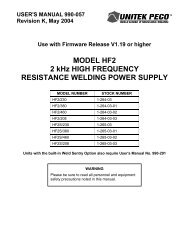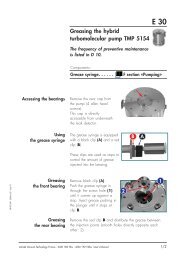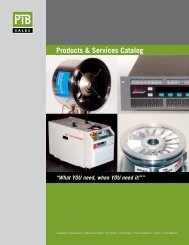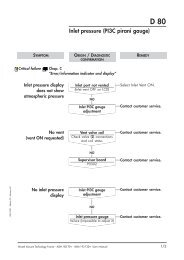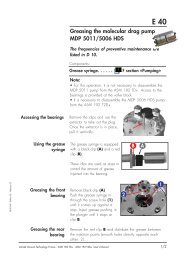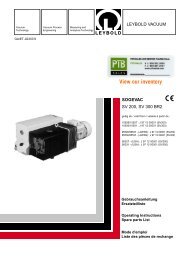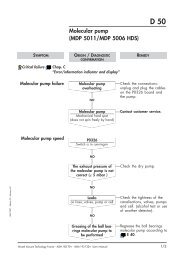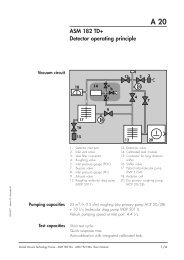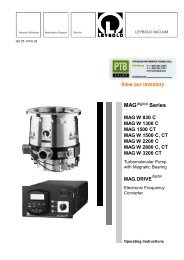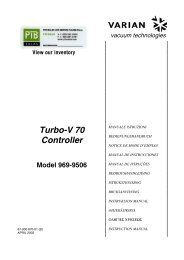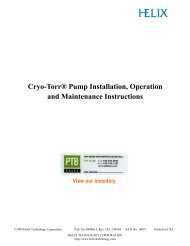VHS-6 Diffusion Pump - Pascal Technologies, Inc
VHS-6 Diffusion Pump - Pascal Technologies, Inc
VHS-6 Diffusion Pump - Pascal Technologies, Inc
Create successful ePaper yourself
Turn your PDF publications into a flip-book with our unique Google optimized e-Paper software.
Varian Vacuum <strong>Technologies</strong><br />
121 Hartwell Avenue<br />
Lexington, MA 02421-3133<br />
(781) 861-7200<br />
(800) 8-VARIAN<br />
<strong>VHS</strong>-6<br />
<strong>Diffusion</strong> <strong>Pump</strong><br />
Instruction Manual<br />
Manual No. 6999-01-022<br />
Revision E<br />
July 2000
Sales and Service Offices<br />
America<br />
Varian Vacuum <strong>Technologies</strong><br />
121 Hartwell Avenue<br />
Lexington, MA 02421,<br />
USA<br />
Tel: (781) 861 7200<br />
Fax: (781) 860 5437<br />
Toll Free: 1 (800) 882 7426<br />
Argentina<br />
Varian Argentina Ltd.<br />
Sucursal Argentina<br />
Av. Ricardo Balbin 2316<br />
1428 Buenos Aires<br />
Argentina<br />
Tel: (54) 1 783 5306<br />
Fax: (54) 1 786 5172<br />
Australia<br />
Varian Australia Pty., Ltd.<br />
6/81 Frenchs Forest Road<br />
Frenchs Forest, NSW 2086<br />
Australia<br />
Tel: (61) 2 9975 8805<br />
Fax: (61) 2 9452 2600<br />
Brazil<br />
Varian Industria e Comercio Ltda.<br />
Avenida Dr. Cardoso de Mello 1644<br />
Vila Olimpia<br />
Sao Paulo 04548 005<br />
Brazil<br />
Tel: (55) 11 820 0444<br />
Fax: (55) 11 820 9350<br />
Canada<br />
Varian Canada<br />
6705 Millcreek Drive, Unit 5<br />
Mississauga, Ontario L5N 5R9<br />
Canada<br />
Tel: (800) 882 7426<br />
Fax: (781) 860 5437<br />
China<br />
Varian China Ltd.<br />
Room 1201, Jinyu Mansion<br />
No. 129A Xuanwumen Xidajie<br />
Xicheng District<br />
Beijing 100031<br />
P.R. China<br />
Tel: (86) 10 6641 1530<br />
Fax: (86) 10 6641 1534<br />
Varian Shanghai<br />
Service Station<br />
716 Yishan Road Shanghai<br />
P.R. China 200233<br />
Tel: (86) 21 6483 5576<br />
Fax: (86) 21 6485 9031<br />
England<br />
Varian Ltd.<br />
28 Manor Road<br />
Walton-On-Thames<br />
Surrey KT 12 2QF<br />
England<br />
Tel: (44) 1932 89 8000<br />
Fax: (44) 1932 22 8769<br />
France<br />
Varian s.a.<br />
7 avenue des Tropiques<br />
Z.A. de Courtaboeuf – B.P. 12<br />
Les Ulis cedex (Orsay) 91941<br />
France<br />
Tel: (33) 1 69 86 38 38<br />
Fax: (33) 1 69 28 23 08<br />
Germany<br />
Varian GmbH<br />
Alsfelder Strasse 6<br />
Postfach 11 14 35<br />
64229 Darmstadt<br />
Germany<br />
Tel: (49) 6151 703 353<br />
Fax: (49) 6151 703 302<br />
Hong Kong<br />
Varian <strong>Technologies</strong> Asia, Ltd.<br />
Rm 2611 Concordia Plaza<br />
New Mandarin Plaza<br />
1 Science Museum Rd.,<br />
Tsimshatsui East, Kowloon<br />
Hong Kong<br />
Tel: (852) 26206173<br />
Fax: (852) 26206338<br />
India<br />
Varian India PVT LTD<br />
1010 Compotent House<br />
7, Nangal Raya Business Centre<br />
New Delhi 110 046<br />
India<br />
Tel: (91) 11 5548444<br />
Fax: (91) 11 5548445<br />
Italy<br />
Varian Vacuum <strong>Technologies</strong><br />
via Flli Varian 54<br />
10040 Leini, (Torino)<br />
Italy<br />
Tel: (39) 011 997 9111<br />
Fax: (39) 011 997 9350<br />
Japan<br />
Varian Vacuum <strong>Technologies</strong><br />
Sumitomo Shibaura<br />
Building, 8th Floor<br />
4-16-36 Shibaura<br />
Minato-ku, Tokyo 108<br />
Japan<br />
Tel: (81) 3 5232 1253<br />
Fax: (81) 3 5232 1263<br />
Korea<br />
Varian <strong>Technologies</strong> Korea, Ltd<br />
Shinsa 2nd Bldg. 2F<br />
966-5 Daechi Dong<br />
Kangnam Gu, Seoul<br />
Korea 135-280<br />
Tel: (82) 2 3452 2452<br />
Fax: (82) 2 3452 2451<br />
Netherlands<br />
Varian Vacuum <strong>Technologies</strong><br />
Rijksstraatweg 269 H,<br />
3956 CP Leersum<br />
The Netherlands<br />
Tel: (31) 343 469910<br />
Fax: (31) 343 469961<br />
Mexico<br />
Varian S.A.<br />
Concepcion Beistegui No 109<br />
Col Del Valle<br />
C.P. 03100<br />
Mexico, D.F.<br />
Tel: (52) 5 523 9465<br />
Fax: (52) 5 523 9472<br />
Singapore<br />
Varian Asia, Ltd.<br />
1123 Serangoon Road<br />
#03-02<br />
Singapore 328207<br />
Tel: (65) 296 9688<br />
Fax: (65) 296 9733<br />
Spain<br />
Varian Iberica<br />
Avda Pedro Diez 25<br />
28019 Madrid<br />
Spain<br />
Tel: (34) 91 4727612<br />
Fax: (34) 91 4725001<br />
Russia<br />
Varian Moscow<br />
19A Khlebny per<br />
121019 Moscow<br />
Russia<br />
Tel: (70) 95 9374280<br />
Fax: (70) 95 9374281<br />
Taiwan<br />
Varian <strong>Technologies</strong> Asia Ltd.,<br />
Taiwan Branch<br />
18F-13 No.79, Hsin Tai Wu Road<br />
Sec. 1, Hsi Chih<br />
Taipei Hsien<br />
Taiwan<br />
Tel: (886) 2 2698 9555<br />
Fax: (886) 2 2698 9678<br />
Internet Users:<br />
Visit us on the web at:<br />
www.eVarian.com<br />
Representatives in most countries
WARRANTY<br />
Products manufactured by Seller are warranted against defects in materials and workmanship for<br />
twelve (12) months from date of shipment thereof to Customer, and Seller's liability under valid warranty<br />
claims is limited, at the option of Seller, to repair, replacement, or refund of an equitable portion<br />
of the purchase price of the Product. Items expendable in normal use are not covered by this warranty.<br />
All warranty replacement or repair of parts shall be limited to equipment malfunctions which, in<br />
the sole opinion of Seller, are due or traceable to defects in original materials or workmanship. All<br />
obligations of Seller under this warranty shall cease in the event of abuse, accident, alteration, misuse,<br />
or neglect of the equipment. In-warranty repaired or replacement parts are warranted only for<br />
the remaining unexpired portion of the original warranty period applicable to the repaired or replaced<br />
parts. After expiration of the applicable warranty period, Customer shall be charged at the then current<br />
prices for parts, labor, and transportation.<br />
Reasonable care must be used to avoid hazards. Seller expressly disclaims responsibility for loss or<br />
damage caused by use of its Products other than in accordance with proper operating procedures.<br />
When products are used with toxic chemicals, or in an atmosphere that is dangerous to the health of<br />
humans, or is environmentally unsafe, it will be the responsibility of the Customer to have the product<br />
cleaned by an independent agency skilled and approved in handling and cleaning contaminated<br />
materials before the product will be accepted by Varian Associates for repair and/or replacement.<br />
Except as stated herein, Seller makes no warranty, express or implied (either in fact or by operation<br />
of law), statutory or otherwise; and, except as stated herein, Seller shall have no liability under any<br />
warranty, express or implied (either in fact or by operation of law), statutory or otherwise. Statements<br />
made by any person, including representatives of Seller, which are inconsistent or in conflict with the<br />
terms of this warranty shall not be binding upon Seller unless reduced to writing and approved by an<br />
officer of Seller.<br />
Warranty Replacement and Adjustment<br />
All claims under warranty must be made promptly after occurrence of circumstances giving rise<br />
thereto, and must be received within the applicable warranty period by Seller or its authorized representative.<br />
Such claims should include the Product serial number, the date of shipment, and a full<br />
description of the circumstances giving rise to the claim. Before any Products are returned for repair<br />
and/or adjustment, written authorization from Seller or its authorized representative for the return and<br />
instructions as to how and where these Products should be returned must be obtained. Any Product<br />
returned to Seller for examination shall be prepaid via the means of transportation indicated as<br />
acceptable by Seller. Seller reserves the right to reject any warranty claim not promptly reported and<br />
any warranty claim on any item that has been altered or has been returned by non-acceptable means<br />
of transportation. When any Product is returned for examination and inspection, or for any other reason,<br />
Customer shall be responsible for all damage resulting from improper packing or handling, and<br />
for loss in transit, notwithstanding any defect or non-conformity in the Product, in all cases, Seller has<br />
the sole responsibility for determining the cause and nature of failure, and Seller's determination with<br />
regard thereto shall be final.<br />
If it is found that Seller's Product has been returned without cause and is still serviceable, Customer<br />
will be notified and the Product returned at its expense; in addition, a charge for testing and examination<br />
may be made on Products so returned.<br />
8/15/95
OPERATION AND MAINTENANCE OF THIS EQUIPMENT INVOLVES SERIOUS RISK. IT IS THE<br />
RESPONSIBILITY OF THE USER TO MAINTAIN SAFE OPERATING CONDITIONS AT ALL TIMES.<br />
VARIAN ASSUMES NO LIABILITY FOR PERSONAL INJURY OR DAMAGE RESULTING FROM<br />
OPERATION OR SERVICE OF THE EQUIPMENT.<br />
Carelessly or improperly operated equipment can cause serious injury or death and/or damage to the<br />
equipment. The emergency and safety procedures in this manual are provided to help users and<br />
qualified persons to operate and service the unit safely. Recommendations are believed to reflect<br />
accepted industry practices in effect on the date of publication of this manual. Special applications<br />
must be reviewed and approved by an industrial hygienist or chemical safety engineer.<br />
Varian has no control over the use of this equipment and is not responsible for personal injury or<br />
damage resulting from its use. The safe use and disposal of hazardous or potentially hazardous<br />
materials of any kind is the sole responsibility of the user. Observe all WARNINGS and CAUTIONS<br />
to minimize the serious hazards involved.<br />
It is the sole responsibility of users of Varian equipment to comply with all local, state, and federal safety<br />
requirements (laws and regulations) applicable to their system. Employ the services of an industrial<br />
hygienist and/or a qualified chemical safety engineer in order to ensure safe installation and use.<br />
This instruction manual contains information which will assist qualified operators in the operation, and<br />
qualified service engineers to carry out field-servicing the Varian equipment.<br />
i
SAFE INCORPORATION OF VARIAN DIFFUSION PUMPS INTO VACUUM SYSTEMS IS THE<br />
RESPONSIBILITY OF THE SYSTEMS DESIGNER. TAKE APPROPRIATE ACTION THROUGH<br />
REDUNDANCY, AND/OR OTHER SAFEGUARDS TO PROTECT PERSONNEL AND PROPERTY<br />
FROM THE HAZARDS DESCRIBED BELOW AND IN THE INSTALLATION, OPERATION, AND<br />
MAINTENANCE INSTRUCTION MANUAL. SAFE OPERATION IS THE RESPONSIBILITY OF THE<br />
USING ORGANIZATION AND ITS PERSONNEL. READ THE INSTRUCTION MANUAL AND<br />
UNDERSTAND HOW TO AVOID HAZARDS PRIOR TO OPERATING THE DIFFUSION PUMP. ALL<br />
PERSONS WHO WORK WITH OR ARE EXPOSED TO DIFFUSION PUMPS OR EQUIPMENT<br />
WHICH UTILIZES SUCH PUMPS OR DIFFUSION PUMP FLUID MUST TAKE PRECAUTIONS TO<br />
PROTECT THEMSELVES AGAINST POSSIBLE SERIOUS BODILY INJURY OR DEATH. DO NOT<br />
BE CARELESS AROUND SUCH PRODUCTS.<br />
THESE SHEETS AND THE INSTALLATION, OPERATION, AND MAINTENANCE INSTRUCTIONS<br />
CAN HELP YOU TO OPERATE THIS PUMP SAFELY AND EFFICIENTLY. READ THEM. SPECIAL<br />
OPERATING CONSIDERATIONS AND PRECAUTIONS WILL BE FOUND IN THE OPERATION<br />
INSTRUCTIONS. UNINFORMED OR CARELESS OPERATION OF THIS PUMP CAN RESULT IN<br />
POOR PERFORMANCE, DAMAGE TO THE PUMP OR OTHER PROPERTY, SERIOUS BODILY<br />
INJURY, AND POSSIBLE DEATH.<br />
USERS OF THIS EQUIPMENT SHOULD BE ALERT TO TWO LEVELS OF HAZARDS IDENTIFIED<br />
BY THE FOLLOWING SYMBOLS:<br />
WARNING<br />
_____________<br />
Warnings are used when failure to observe instructions or precautions<br />
could result in injury or death to humans.<br />
CAUTION ________<br />
Cautions are used when failure to observe instructions could result in<br />
significant damage to equipment and/or facilities.<br />
Designers of systems which utilize diffusion pumps must design out hazards wherever possible; provide<br />
guards, safety features, and interlocks for hazards which cannot be designed out; warn with<br />
respect to hazards which cannot be designed out and which remain after utilizing guards, safety features,<br />
and interlocks; and lastly, provide procedures and instructions on proper use, servicing, etc., so<br />
as to minimize risk.<br />
ii
THE INSTALLATION, OPERATION, AND/OR SERVICING OR DIFFUSION PUMPS INVOLVES ONE<br />
OR MORE OF THE FOLLOWING HAZARDS, ANY ONE OF WHICH, IN THE ABSENCE OF SAFE<br />
OPERATING PRACTICES AND PRECAUTIONS, COULD POTENTIALLY RESULT IN DEATH OR<br />
SERIOUS HARM TO PERSONNEL.<br />
Hazard<br />
Loss of utility: water and/or electricity<br />
Overpressure in foreline<br />
Overtemperature<br />
Insufficient water flow through the<br />
main cooling coils<br />
Water trapped between inlet and<br />
outlet of quick-cool coil, or liquid<br />
nitrogen trapped between inlet and<br />
outlet of liquid nitrogen trap<br />
Loss of ground integrity<br />
Positive pressure in pumping system<br />
High voltage<br />
Toxicity/Corrosivity<br />
Suggested Corrective Action<br />
Provide sufficient water and backup power to effect a safe<br />
shutdown under worst case conditions.<br />
Provide an interlock to ensure that the power supply to<br />
the pump heater cannot be activated if the foreline pump<br />
is not running AND/OR pressure in foreline is above<br />
0.5 Torr (66.5 Pa).<br />
Fit temperature sensors and pump fluid level sensors with<br />
feedback to an interlock on the heater power supply.<br />
Use water flow sensor and feedback to interlock on the heater<br />
power supply.<br />
Provide vent or pressure relief valves for both quick-cool coil<br />
and liquid nitrogen trap.<br />
<strong>Inc</strong>orporate ground fault interrupt circuit into heater<br />
power supply.<br />
Integrate pressure relief valve in vacuum system.<br />
Prevent personnel contact with high voltages; design and<br />
attach warnings.<br />
Toxic and/or corrosive gases must be vented to a safe<br />
location, ensuring adequate dilution or scrubbing to safe<br />
levels, taking all action required to meet air quality standards.<br />
iii
Explosion<br />
Hazard<br />
Suggested Corrective Action<br />
Integrate pressure relief valves in all systems using pumps<br />
10 inches or larger in diameter.<br />
Do not use or recommend the use of hydrocarbon-based<br />
pumping oils.<br />
a. Explosion – Operation of the diffusion pump without prior and continuous evacuation (below 0.5<br />
Torr (66.5 Pa)) or coolant and introducing a strong oxidizer (such as air) or explosive vapors or<br />
powders or materials which may react with pumping fluids into a hot (above 300°F or 150°C) pump<br />
can cause an explosion. Such an explosion can violently expel valves and other hardware, slam<br />
open doors that are not designed for appropriate pressure relief, or burst other components of the<br />
vacuum system. Serious injury or death may result from expelled parts, doors, shrapnel, and/or<br />
shock waves.<br />
b. All diffusion pumps are typically cleaned with acetone or alcohol. When combined with air, oxygen,<br />
and other oxidizers, alcohol and most other solvents are very flammable and explosive. Never permit<br />
any trace of these cleaners to remain in or on the pump. Always remove all traces of alcohol<br />
and acetone and other cleaners with clean, dry, oil-free compressed air.<br />
Three elements are required: fuel, oxidizer, and source of ignition. A combination of temperature and<br />
pressure can be a source of ignition. Most diffusion pump fluids except mercury are fuels. Hydrocarbon<br />
oils are more prone to oxidize and explode than synthetic silicone-based oil. Oxidizers can be air (a<br />
strong oxidizer) from a leak or can be deliberately introduced in a process or can be inadvertently<br />
admitted to the system by operator or process controller error. Oxygen and other strong oxidizers are<br />
even more dangerous. Certain conditions of temperature and pressure can cause a combustible mixture<br />
to explode. The larger the diffusion pump, the greater the risk of explosion and the greater the risk<br />
of damage and/or injury. Never operate diffusion pumps larger than 10 inches in diameter with hydrocarbon<br />
oils without a full safety analysis for the complete system and application. Never operate any diffusion<br />
pump in the following ways because they increase the probability of an explosion.<br />
Prohibited Action<br />
Run pump with no cooling water<br />
Run pump with low level of<br />
pump fluid<br />
Run pump without proper backing or<br />
holding pump<br />
Run pump when not evacuated below<br />
0.5 Torr (66.5 Pa)<br />
Admit air to, or rough through,<br />
a pump with hot boiler<br />
Explosion-Causing Condition<br />
Overtemperature<br />
Overtemperature<br />
Overpressure<br />
Overpressure<br />
Overpressure plus strong oxidizer<br />
iv
Prohibited Action<br />
Open drain or fill plug while pump is<br />
under vacuum, especially when it is hot<br />
Contaminate pump with explosive vapors,<br />
powders, or reactive materials<br />
Remove, defeat, or override safety countermeasures<br />
such as pressure and thermal<br />
switches and valve sequencer interlocks<br />
Machine or weld without removing all oil<br />
or solvent residue in pump<br />
Use unsuitable pumping fluid especially<br />
in large pumps<br />
Explosion-Causing Condition<br />
Overpressure plus strong oxidizer<br />
Lower explosive threshold of gas mixtures<br />
Overtemperature, overpressure, more<br />
combustible mixtures<br />
Source of ignition<br />
Lower explosive threshold of gas mixture<br />
Systems larger than 10 inches must be designed with pressure relief devices to provide safe pressure<br />
relief from internal explosions. Always recognize that safety devices can fail or malfunction. Provide<br />
redundant protection by installing devices having different failure modes, failure mechanisms,<br />
and failure causes. Be certain that exhaust duct materials are capable of withstanding the corrosivity,<br />
temperature, and pressure of exhausted products.<br />
c. Pressure – <strong>Pump</strong>s and their components are designed for vacuum service; they are not designed<br />
to be pressurized which could cause them to burst possibly expelling shrapnel at lethal velocities.<br />
Serious accidents have been caused by intentional pressurization of vacuum systems and their<br />
components. Never pressurize any part of a vacuum system for test or any other purpose.<br />
Always provide pressure relief when designing diffusion pumps into systems and ensure that pressure<br />
relief motion is limited to safe envelopes. Never permit the following:<br />
Prohibited Action<br />
Block inlet and vent of liquid nitrogen<br />
trap and lines<br />
Close isolation valves at inlet and discharge<br />
of main watercooling coils and pump is<br />
reheated<br />
Pressurize pump body<br />
Hole through vacuum wall<br />
Result<br />
LN 2 trap and/or lines burst<br />
Water turns to steam and bursts coils<br />
Body of pump bursts<br />
Loss of structural integrity of wall<br />
v
d. Poisonous and/or Corrosive Compounds – When pumping poisonous, reactive, and/or corrosive<br />
gas, vapors, or chemicals, even proper operation and regeneration will not always ensure that all<br />
hazardous materials have been totally removed. If hazardous gas, vapors, chemicals, or combustible<br />
mixtures are pumped, sufficient quantities may exist during operation or remain after regeneration to<br />
cause severe injury or death. Overheating the pump oil, exposing it to air or reactive materials, or<br />
overpressurizing it above the normal operating range (approximately 1mTorr (.133 Pa)) will decompose<br />
the oil and possibly make it toxic. This is especially true of backstreamed mechanical pump oils<br />
which are more volatile (unstable). Overheating of accidentally introduced or backstreamed mechanical<br />
pump oils cannot be protected against by thermal switches which are set for diffusion pump oil.<br />
d. Refer to specific instruction manuals for detailed instructions and precautions. Always vent the<br />
pump and relief valve to a safe location thus ensuring adequate dilution to safe levels, and take all<br />
other action required to meet quality air standards. Always handle pump fluids and hardware with<br />
an awareness of the possible deadly hazards involved and the necessity for great care and attention<br />
to safety precautions.<br />
d. <strong>Diffusion</strong> pumps are typically cleaned with acetone or alcohol. Acetone, alcohol, and most other<br />
solvents are irritants, narcotics, and depressants, and/or carcinogenic. Their inhalation and ingestion<br />
may produce serious effects. Even absorption through the skin can result in moderate toxicity.<br />
Always ensure that cleaning operations are performed in large, well-ventilated rooms. Use of selfcontained<br />
breathing apparatus may be necessary depending upon the solvent type and vapor<br />
concentration in surrounding air.<br />
e. High Voltage – <strong>Diffusion</strong> pumps operate at voltages high enough to kill through electrical shock.<br />
Design equipment utilizing these pumps to prevent personnel contact with high voltages. Securely<br />
attach prominent hazard warnings. Personnel should always break the primary circuit to the power<br />
supply when direct access to the heater or wiring is required.<br />
f. Hot Surfaces – Boiler temperatures reach 530°F (275°C) which can cause serious burns when<br />
touched. Always ensure that surfaces have cooled near room temperature before touching them.<br />
g. Hot Coolant and/or Steam – The water used to cool the pump can reach scalding temperatures.<br />
Touching or rupture of the cooling surface can cause serious burns. Water left inside quick cool<br />
coils from previous use will turn to steam when the pump is reheated. This steam must be allowed<br />
to escape without contacting personnel. Whenever possible, design the water system with interlock<br />
valves so that power cannot be applied to the pump unless water is flowing in the main cooling<br />
coils (not quick-cooling coils).<br />
h. Cold Surfaces – Liquid nitrogen traps cooled by liquid nitrogen are commonly used in diffusion<br />
pumps. Metal surfaces at liquid nitrogen temperature can cause severe frostbite if contacted by<br />
unprotected skin. These surfaces remain cold for some time (at least a half hour) after the liquid<br />
nitrogen has evaporated.<br />
vi
i. Cold Coolant – Liquid nitrogen, a cryogenic liquid, is used in traps. If it is splashed on body tissues<br />
or eyes, it can cause severe frostbite or blindness. The extremely low temperature of liquified nitrogen<br />
can cause skin damage similar to high temperature burns. Contact with the cold gas evolving<br />
from the liquid may produce the same effect. Delicate tissues, such as the eye tissues, are most<br />
easily damaged by exposure to cold gas or liquid. To minimize the risk of hazardous contact of cold<br />
gaseous nitrogen with any part of the body, wear personal safety equipment recommended for use<br />
with cryogenic materials including face shield, full-sleeved lab coat, and clean, dry gloves which fit<br />
loosely so they can be thrown off quickly if frozen by contact with the gas.<br />
j. Asphyxiation – If a large amount of liquid nitrogen is spilled in a small, poorly ventilated room or<br />
equipment, death from suffocation can result. All diffusion pumps are typically cleaned with acetone<br />
or alcohol. Acetone, alcohol, and most other solvents are very volatile (unstable). During cleaning,<br />
the volatility of these cleaners may permit their gases to displace air and its life-supporting oxygen<br />
which could cause death or serious injury by asphyxiation. Always ensure that cleaning operations<br />
are performed in large, well-ventilated areas.<br />
j. While still hot, the diffusion pump may also contain decomposed and/or overheated pump oils<br />
which can also be an asphyxiant.<br />
k. Large, Heavy Weights – <strong>Diffusion</strong> pumps larger than 10 inches in diameter require powerassisted<br />
equipment and the use of trained moving/installation personnel in order to avoid<br />
dropping, slipping, and/or overturning the pump thus severely injuring personnel. Check weight<br />
of equipment before lifting and do not stand under equipment being moved.<br />
vii
WARNING<br />
_____________<br />
High voltages can kill. Always break the primary circuit to the power<br />
supply before starting to work on the heater and/or its wiring.<br />
WARNING<br />
_____________<br />
<strong>Diffusion</strong> pumps are typically cleaned with acetone, alcohol, or other<br />
solvents.<br />
When heated, sprayed or exposed to high temperature equipment,<br />
these solvents become flammable and explosive, causing serious injury<br />
or death. Do not use near a high-temperature source. Ventilate working<br />
area with a blower and use in large, well-ventilated room. When<br />
heated or sprayed, solvents also becomes 4 to 5 times heavier than air<br />
and will flow down, settling in tanks, pits, and low areas, thus displacing<br />
air which can kill by asphyxiation. Use in a large, well-ventilated room.<br />
Use of a self-contained breathing apparatus may be necessary.<br />
Acetone, alcohol, and other solvents are irritants, narcotics, depressants,<br />
and/or carcinogenics. Their inhalation and/or ingestion may produce<br />
serious effects. Prolonged or continued contact with the skin will<br />
result in absorption through the skin and moderate toxicity. Always<br />
ensure that cleaning operations are carried out in large, well-ventilated<br />
rooms, and wear eyeshields, gloves, and protective clothing.<br />
WARNING<br />
_____________<br />
Varian has no control over the types of gases passing through this<br />
pump. These are entirely under the control of the process user and/or<br />
the hardware systems integrator. Frequently, process gases are toxic,<br />
flammable, corrosive, explosive, or otherwise reactive. Since these<br />
gases can cause serious injury or death, it is very important to plumb<br />
the exhaust of the pump to the facility’s hazardous gas exhaust system<br />
which incorporates appropriate filters, scrubbers, etc., to insure that the<br />
exhaust meets all air and water pollution control regulations.<br />
WARNING<br />
_____________<br />
Certain gases can become corrosive and toxic when trapped in oil.<br />
Always wear protective gloves when handling dirty pump oil, drain it into<br />
a closable container, and do not breathe the fumes of the oil. Always<br />
use fully self-contained breathing apparatus.<br />
viii
WARNING<br />
_____________<br />
Hot oils can cause serious burns. Wear protective gloves and long<br />
sleeved, loose fitting, heat resistant garments when draining pump oil.<br />
WARNING<br />
_____________<br />
When lifting some Varian diffusion pumps, use power-assisted equipment<br />
and trained moving/installation personnel to avoid dropping, slipping,<br />
and/or overturning the pump and severely injuring personnel.<br />
Check weight of equipment before lifting and do not stand under equipment<br />
being moved.<br />
CAUTION ________<br />
Alcohol, acetone, and other solvents degrade O-ring materials reducing<br />
their ability to hold a vacuum. Do not use acetone or other solvents on<br />
O-rings. If necessary to clean O-rings, wipe with lint-free, clean cloth,<br />
wash in detergent and water, or use a small amount of pump oil.<br />
NOTE ________<br />
Always dispose of used or dirty oil properly and in compliance with all<br />
local, state, and federal environmental laws and regulations.<br />
ix
Table of Contents<br />
Section<br />
Page<br />
Section I – Installation . . . . . . . . . . . . . . . . . . . . . . . . . . . . . . . . . . . . . . . . . . . . . . . . . . . . . . . . 1-1<br />
1-1 Specifications . . . . . . . . . . . . . . . . . . . . . . . . . . . . . . . . . . . . . . . . . . . . . . . . . . . . . . . . . . 1-1<br />
1-2 Installation . . . . . . . . . . . . . . . . . . . . . . . . . . . . . . . . . . . . . . . . . . . . . . . . . . . . . . . . . . . . . 1-2<br />
1-2-1 Unpacking . . . . . . . . . . . . . . . . . . . . . . . . . . . . . . . . . . . . . . . . . . . . . . . . . . . . . . . . . . . . . 1-2<br />
1-2-2 <strong>Pump</strong> Oil Installation . . . . . . . . . . . . . . . . . . . . . . . . . . . . . . . . . . . . . . . . . . . . . . . . . . . . . 1-2<br />
1-2-3 Vacuum System Connections . . . . . . . . . . . . . . . . . . . . . . . . . . . . . . . . . . . . . . . . . . . . . . 1-2<br />
1-2-4 Cooling Water Connections . . . . . . . . . . . . . . . . . . . . . . . . . . . . . . . . . . . . . . . . . . . . . . . . 1-3<br />
1-2-5 Electrical Connections . . . . . . . . . . . . . . . . . . . . . . . . . . . . . . . . . . . . . . . . . . . . . . . . . . . 1-3<br />
1-2-6 Thermal Switch . . . . . . . . . . . . . . . . . . . . . . . . . . . . . . . . . . . . . . . . . . . . . . . . . . . . . . . . . 1-4<br />
Section II – Operation . . . . . . . . . . . . . . . . . . . . . . . . . . . . . . . . . . . . . . . . . . . . . . . . . . . . . . . . 2-1<br />
2-1 Startup Procedure . . . . . . . . . . . . . . . . . . . . . . . . . . . . . . . . . . . . . . . . . . . . . . . . . . . . . . . 2-1<br />
2-2 Shutdown Procedure . . . . . . . . . . . . . . . . . . . . . . . . . . . . . . . . . . . . . . . . . . . . . . . . . . . . . 2-2<br />
Section III – Maintenance and Service . . . . . . . . . . . . . . . . . . . . . . . . . . . . . . . . . . . . . . . . . . . 3-1<br />
3-1 General . . . . . . . . . . . . . . . . . . . . . . . . . . . . . . . . . . . . . . . . . . . . . . . . . . . . . . . . . . . . . . . 3-1<br />
3-2 Periodic Inspection . . . . . . . . . . . . . . . . . . . . . . . . . . . . . . . . . . . . . . . . . . . . . . . . . . . . . . 3-1<br />
3-3 Cleaning . . . . . . . . . . . . . . . . . . . . . . . . . . . . . . . . . . . . . . . . . . . . . . . . . . . . . . . . . . . . . . 3-1<br />
3-4 Cold Cap Removal/Installation . . . . . . . . . . . . . . . . . . . . . . . . . . . . . . . . . . . . . . . . . . . . . 3-2<br />
3-5 Jet Assembly Removal/Installation . . . . . . . . . . . . . . . . . . . . . . . . . . . . . . . . . . . . . . . . . . 3-3<br />
3-6 Heater Replacement . . . . . . . . . . . . . . . . . . . . . . . . . . . . . . . . . . . . . . . . . . . . . . . . . . . . . 3-4<br />
3-7 Adding <strong>Pump</strong> Fluid . . . . . . . . . . . . . . . . . . . . . . . . . . . . . . . . . . . . . . . . . . . . . . . . . . . . . . 3-4<br />
Section IV – Troubleshooting . . . . . . . . . . . . . . . . . . . . . . . . . . . . . . . . . . . . . . . . . . . . . . . . . . 4-1<br />
4-1 Leakage . . . . . . . . . . . . . . . . . . . . . . . . . . . . . . . . . . . . . . . . . . . . . . . . . . . . . . . . . . . . . . 4-1<br />
4-2 Outgassing . . . . . . . . . . . . . . . . . . . . . . . . . . . . . . . . . . . . . . . . . . . . . . . . . . . . . . . . . . . . 4-1<br />
4-3 Poor <strong>Pump</strong> or System Performance . . . . . . . . . . . . . . . . . . . . . . . . . . . . . . . . . . . . . . . . . 4-1<br />
Section V – Replacement Parts . . . . . . . . . . . . . . . . . . . . . . . . . . . . . . . . . . . . . . . . . . . . . . . . 5-1<br />
x
SECTION I<br />
INSTALLATION<br />
Before unpacking and installing the <strong>VHS</strong>-6 <strong>Diffusion</strong> <strong>Pump</strong>, the user should thoroughly familiarize<br />
himself with this instruction manual and the diffusion pump specifications (see Table 1). He should<br />
also examine all other technical material supplied in order to gain a better understanding of the operating<br />
principles, limitations, correct application, and the hazards involved with the use of this equipment.<br />
1-1 SPECIFICATIONS<br />
Table 1 lists the specifications for all standard type 0184 models of the pump.<br />
Table 1. <strong>Pump</strong> Specifications<br />
Power Rating<br />
2200 watts<br />
Optimum Operating Range<br />
1 x 10 -3 to
Installation<br />
Heater circuit resistance (ohms)<br />
Clearance (for heater removal)<br />
Materials<br />
Body, flanges, foreline baffle<br />
Jet Assembly<br />
Body Cooling Coils<br />
Quick Cooling Coil<br />
Cold cap<br />
Shipping Weight<br />
2200 watts<br />
120V 6.5<br />
208V 19.6<br />
240V 26.1<br />
6 inches minimum<br />
Stainless steel<br />
Stainless steel<br />
Copper<br />
Stainless steel<br />
Nickel-plated copper<br />
75 pounds<br />
1-2 INSTALLATION<br />
1-2-1 Unpacking<br />
a<br />
b<br />
c<br />
Inspect the pump to ensure that no damage has occurred during shipping. Do not discard any<br />
evidence of rough handling; any damage should be reported to the carrier and to Varian without<br />
delay.<br />
<strong>Diffusion</strong> pumps are factory-packed to permit prolonged storage in suitably protected areas<br />
without special precautions.<br />
Remove flange covers and protective plugs from water connections. Be careful not to scratch<br />
the O-ring seal surface on the inlet and foreline flanges.<br />
d Inspect the internal jet assembly. It should be concentric and firmly seated on the bottom of<br />
the diffusion pump. Using a flashlight, check to ensure that the ejector nozzle is directly in line<br />
with the foreline. The location of the jet is controlled by an indexing pin located on the bottom<br />
of the pump.<br />
e The pump requires no initial cleaning if the required vacuum level is above 10 -6 Torr (.000133<br />
Pa). For pressure below 10 -6 Torr (.000133 Pa), follow the cleaning procedure in the<br />
Maintenance section. Then charge the pump with the diffusion pump oil shipped with the<br />
pump.<br />
1-2-2 <strong>Pump</strong> Oil Installation<br />
a<br />
b<br />
The recommended oil charge for the <strong>VHS</strong>-6 diffusion pump is 500 cc.<br />
The oil is normally poured into the pump inlet or the foreline or by removing the fill plug and<br />
pouring it into the fill and drain assembly.<br />
WARNING<br />
_____________<br />
Utility failure can cause damage to the equipment, overheating, and<br />
explosions. Designers of the equipment using diffusion pumps must<br />
take appropriate system design action to protect personnel and property<br />
from possible hazards. Read the safety section at the beginning<br />
of this manual.<br />
1-2
Installation<br />
1-2-3 Vacuum System Connections<br />
a<br />
b<br />
c<br />
d<br />
e<br />
f<br />
The diffusion pump must be installed with the body vertical and plumb. Check to ensure that<br />
the pump inlet mating flange on the system is horizontal within ± one degree. The boiler plate<br />
must be horizontal to prevent uneven fluid level. Failure to meet this requirement could result<br />
in overheating of the diffusion pump boiler plate.<br />
Prepare the inlet and foreline O-rings by wiping them with a clean, lint-free cloth. A small<br />
amount of diffusion pump oil may be used to clean the O-rings.<br />
Install the O-rings in the O-ring grooves. Be careful not to damage or scratch the sealing surface.<br />
Check the fill plug for tightness. Apply light to medium torque, enough to compress the O-rings.<br />
Using the appropriate lifting apparatus, align the bolt holes of the inlet flange with the bolt<br />
holes of the mating flange. Using the appropriate mounting hardware, tighten the bolts evenly<br />
until the O-ring is compressed and the flanges make light, metal-to-metal contact.<br />
To ensure the integrity of the vacuum connections, they should be checked for leaks using a<br />
helium mass spectrometer leak detector before operating the vacuum system.<br />
1-2-4 Cooling Water Connections<br />
NOTE ________<br />
In the following step, discharge connections must be installed in accordance<br />
with all Federal, State, and local laws and regulations.<br />
a<br />
b<br />
c<br />
d<br />
e<br />
f<br />
The inlet water fitting (near the inlet flange at the top of the pump) should be connected to a<br />
continuously running water supply at 0.25 gpm and at a temperature of 60 to 80oF.<br />
The exit water temperature should not exceed 120°F.<br />
The outlet or discharge (nearest the foreline) should be connected to an open drain.<br />
If the diffusion pump is being cooled by a recirculating water system, the system must be<br />
capable of adequate cooling and heat exchange to ensure a continuous inlet temperature of<br />
60 to 80°F. The recirculating system must also be capable of maintaining an adequate flow<br />
rate to ensure that exit water temperature does not exceed 120°F. The minimum rating of this<br />
system should be 85 percent of the maximum power rating of the diffusion pump.<br />
The quick cool coil feed line, located at the boiler plate, shoud be controlled by a separate<br />
three-way valve (open, closed, and vent to atmosphere).<br />
The quick cool drain must be connected to an open drain which is below the inlet connection<br />
of the quick cool coil. This will ensure that the quick cool coil is completely drained when the<br />
cooling water supply is turned off and the pump is vented to atmosphere.<br />
WARNING<br />
<strong>Diffusion</strong> pump heaters operate at voltages high enough to kill through<br />
electrical shock. During installation, check the drawings and be sure to<br />
attach all hazard warnings and cautions. Always break the primary circuit<br />
of the power supply when direct access to the heater or wiring is<br />
required. Read the safety section in the front of this manual.<br />
1-3
Installation<br />
1-2-5 Electrical Connections<br />
a<br />
b<br />
c<br />
The diffusion pump has been designed to operate at a specific voltage. The voltage is<br />
specified on the label that is mounted on the side of the pump. Verify the heater rating by<br />
measuring the resistance of the heater circuit (line-to-line) and comparing it to the values in<br />
Table 1-1, Specifications.<br />
Make the electrical connections in the junction box located near the foreline. The electrical<br />
supply should not be more than 5 percent above the rated voltage.<br />
All electrical connections should be made in accordance with all applicable State, local,<br />
and/or industrial codes.<br />
1-2-6 Thermal Switch<br />
a<br />
The pump has been fitted with a manually-resettable thermal switch that is preset at the<br />
WARNING<br />
Failure to properly connect the thermal switch circuit in the following<br />
step could result in catastrophic damage to personnel, the pump, or the<br />
vacuum system.<br />
factory. This switch is located in a box near the bottom of the pump and provides protection to<br />
the pump in the event of excessive fluid loss, the loss of cooling water, or high inlet pressure.<br />
b<br />
c<br />
The thermal switch is connected in series with the heater. In the event of overtemperature, the<br />
thermal switch will open and shut off the power to the pump.<br />
The thermal switch may be reset by pressing the button located at the center of the thermal<br />
1-4
switch. This should be done only after the root cause of a problem has been determined and<br />
the appropriate corrective action taken.<br />
SECTION II<br />
CAUTION ________<br />
Damage to <strong>Pump</strong><br />
Do not turn on the heater without fluid in the pump. This may ruin the<br />
heaters and damage the pump.<br />
Damage to <strong>Pump</strong> Fluid<br />
• Do not air-release the pump while the boiler is hot. Most diffusion pump<br />
fluids are heat-sensitive and will break down under these conditions.<br />
• Do not operate the pump without the internal splash baffle or foreline<br />
baffle in place. If the splash baffle is omitted, the pump may be unstable<br />
and operate at low speed. If the foreline baffle is omitted, there<br />
may be more than usual fluid loss.<br />
• Do not operate the pump for extended periods at inlet pressures above 1<br />
micron (.133 Pa). High-pressure operation may cause excessive backstreaming.<br />
• Do not operate the pump heater unless the cooling water is circulating.<br />
It wlll cause the pump and fluid to overheat.<br />
OPERATION<br />
2-1 STARTUP PROCEDURE<br />
a<br />
b<br />
c<br />
d<br />
e<br />
f<br />
g<br />
During initial operation of the diffusion pump, a fresh charge of diffusion pump oil may go<br />
through a degassing process. This may result in inlet and foreline pressure fluctuations. These<br />
pressure fluctuations are normal.<br />
Visually inspect the sight glass assembly to ensure that the diffusion pump has been charged<br />
with the proper amount of diffusion pump fluid. When properly filled, the oil level (when the<br />
pump is cold) will be even with the FULL/COLD mark on the oil level indicator.<br />
Evacuate (rough pump) the diffusion pump with a mechanical backing pump (customersupplied).<br />
The pressure must be reduced to less than 0.5 Torr. The backing pump should<br />
remain connected to the foreline of the diffusion pump.<br />
Turn on the cooling water supply to the pump body. Check that the cooling water is not being<br />
supplied to the quick cool coil at this time.<br />
Turn on the power to the diffusion pump heater.<br />
Monitor inlet and foreline pressures.<br />
During operation of the diffusion pump, the gas load at the inlet should not exceed the<br />
maximum throughput capability of the pump. The forepressure should not exceed the<br />
specified tolerable forepressure.<br />
2-1
Operation<br />
2-2 SHUTDOWN PROCEDURE<br />
a<br />
b<br />
Turn off the power to the diffusion pump. Continue to back the diffusion pump with the appropriate<br />
mechanical pump.<br />
Allow cooling water to flow through the diffusion pump until the pump body temperature,<br />
located just above the boiler plate, has cooled to a temperature of approximately 130°F.<br />
2-2
c<br />
d<br />
After isolating the backing pump, the diffusion pump may be vented to atmosphere.<br />
If faster cooling is desired, the pump can be cooled using the quick cool coil at the bottom of<br />
the diffusion pump. Follow the instructions in para. 1-3-3 for proper setup of the quick cool coil<br />
line. The same procedure for shutdown can be followed.<br />
SECTION III<br />
MAINTENANCE AND SERVICE<br />
3-1 GENERAL<br />
<strong>Diffusion</strong> pumps generally require little attention when operated correctly. It is advisable to perform<br />
some periodic inspections to ensure trouble-free operation. By performing simple preventive maintenance,<br />
costly downtime can be avoided. A day-to-day log of pump and system performance will help<br />
indicate the condition of the pump and the need for corrective action.<br />
3-2 PERIODIC INSPECTION<br />
The frequency of inspection will depend on the type of system, its operation, and use. The maximum<br />
interval between inspections is established on the basis of experience. It is recommended that the<br />
following items be regularly examined.<br />
a<br />
b<br />
c<br />
d<br />
e<br />
When the pump is cold, check the condition and level of the fluid. These can be inspected by<br />
withdrawing a fluid sample through the drain and by visually checking the level of the fluid<br />
through the sight glass. A slight discoloration of the fluid does not affect performance. Always<br />
use new o-rings when replacing fill plugs or the sight glass.<br />
Loss of fluid can be caused by the following:<br />
1 <strong>Inc</strong>orrect venting procedures and/or admittance of excessive air or other gas to a hot pump.<br />
2 Inadequate water cooling.<br />
3 Prolonged operation at inlet pressures above 10 -3 Torr (.133 Pa).<br />
4Failure to reinsert the foreline baffle in the pump assembly.<br />
Check the total heater power input.<br />
When the pump is cold and the power is off, check to ensure that the heater is bolted snugly<br />
to the boiler plate. Also check all heater terminal connections at the heater and inside the<br />
junction box and make certain that they are tight and in good condition.<br />
Check to ensure that cooling water flow is adequate and unobstructed. In areas where the<br />
mineral content of the water is high or where there is considerable sediment, it may be advisable<br />
to install water filters.<br />
3-3 CLEANING<br />
Complete cleaning of the pump may be periodically required because of the gradual deterioration of<br />
some pump fluids. Removal of the pump from the system is then necessary.<br />
a<br />
b<br />
Turn off the power and disconnect the power supply plug.<br />
After the pump has cooled, turn off the cooling water and disconnect the cooling lines.<br />
3-1
Maintenance and Service<br />
c<br />
d<br />
e<br />
f<br />
g<br />
h<br />
i<br />
j<br />
k<br />
l<br />
m<br />
Unbolt the inlet flange and foreline connections. Remove the pump from the system.<br />
Drain the diffusion pump of all fluid.<br />
Remove all O-rings, the cold cap assembly, the jet assembly, and the foreline baffle from the<br />
pump.<br />
Thoroughly clean the diffusion pump body interior and the jet assembly using acetone<br />
followed by an isopropyl alcohol rinse. Dry the pump and the jet assembly with clean,<br />
dry, oil-free compressed air.<br />
Install the foreline baffle, the jet assembly, and the cold cap assembly in the pump body.<br />
Check that the ejector nozzle is properly aligned with the foreline. Also check that the cold cap<br />
is properly installed on the jet assembly. The space between the underside of the cold cap<br />
and the outside of the jet cap should be uniform.<br />
Reinstall the diffusion pump in the system using all new O-rings.<br />
Charge the pump with the proper amount of fluid.<br />
Reconnect the water cooling lines and the power supply.<br />
Evacuate the diffusion pump with the appropriate mechanical pump.<br />
Turn on the cooling water.<br />
After the pump has been evacuated to a pressure below 0.5 Torr (66.5 Pa), turn on the<br />
power to the diffusion pump.<br />
3-4 COLD CAP REMOVAL/INSTALLATION (Refer to Figure 3-1)<br />
To remove the cold cap, proceed as follows.<br />
a<br />
b<br />
Remove the spring (1) attached by no. 6-32 x 3 ⁄16 round head screw (2), a flat washer (3), and<br />
a lockwasher (4).<br />
Loosen the nut (5) holding the cold cap bracket (6) to the copper bar (A) and remove the<br />
cold cap (7) from the top of the jet cap (8).<br />
c Unscrew the no. 8-32 x 1 ⁄4 socket head cap screw (9) from the top of the ceramic standoff (10).<br />
d Remove the ceramic standoff (10) and the no. 8-32 x 1 ⁄2 stud (11).<br />
To install the cold cap, proceed as follows.<br />
a Replace the stud (11) and the ceramic standoff (10) in the jet cap (8).<br />
b<br />
Thread the no. 8-32 x 1 ⁄4 socket head cap screw (9) finger-tight into the top of the ceramic<br />
standoff (10). Be careful not to crack the ceramic standoff.<br />
c Carefully place the cold cap (7) on top of the jet cap (8), align the cold cap bracket (6)<br />
with the copper bar (A), and level the cold cap as accurately as possible.<br />
NOTE ________<br />
In the following step, be sure that no strain is applied to the ceramic<br />
standoff when tightening the nut (5) at the copper bar (A).<br />
d<br />
Tighten the nut (5) at the copper bar (A).<br />
3-2
Maintenance and Service<br />
Figure 3-1 Cold Cap Removal/Installation<br />
e<br />
Install the spring (1) attached by the screw, (2) and washers (3 and 4). Torque the sccrew to<br />
10 to 12 inch lbs.<br />
3-5 JET ASSEMBLY REMOVAL/INSTALLATION<br />
To remove the jet assembly, proceed as follows.<br />
a<br />
b<br />
Remove the cold cap from the pump.<br />
Unscrew the top cap from the jet assembly.<br />
c Lift out each section of the jet assembly. Do not dent or otherwise damage the jet assembly<br />
during disassembly or cleaning.<br />
d<br />
Remove the splash baffle from the pump.<br />
To install the jet assembly, proceed as follows.<br />
a<br />
Place the splash baffle in the bottom of the pump. Check that it is located in the outer boiler<br />
groove.<br />
3-3
Maintenance and Service<br />
b<br />
c<br />
Insert the jet base, making sure the ejector is aligned with the foreline (a keyway in the jet<br />
base will assure alignment). Assemble the remaining stages of the jet. Make sure that all<br />
stages are firmly seated and that all drip shields are in place.<br />
Install the cold cap assembly.<br />
3-6 HEATER REPLACEMENT<br />
a<br />
b<br />
c<br />
d<br />
e<br />
f<br />
g<br />
h<br />
j<br />
k<br />
Turn off the power to the diffusion pump and disconnect the power supply.<br />
Remove the heater cover and the insulation from the bottom of the diffusion pump.<br />
Label the heater wires for proper location during installation.<br />
Disconnect the terminal leads. Use two wrenches when loosening these nuts to prevent<br />
breaking the heater terminals.<br />
Remove the nuts holding the heater clamp.<br />
Lower the entire heater unit from the pump.<br />
Replace the defective heater.<br />
Assemble the heater, the crush plate, and the clamping plate as a unit.<br />
Coat the boiler studs with an antiseize compound such as FEL-PRO C5A or common milk of<br />
magnesia.<br />
Support the heater unit by the clamping plate, line up the hole with the boiler stud, and push<br />
the unit up against the boiler plate. Use two nuts, tightened finger-tight, to hold it in place.<br />
l Secure the remainder of the nuts finger-tight, then tighten the bolts evenly to a torque of 250<br />
inch-pounds.<br />
m<br />
Replace the heater insulation and the cover.<br />
3-7 ADDING PUMP FLUID<br />
The recommended fluid charge for the <strong>VHS</strong>-6 diffusion pump is 500 cc. The fluid charge will gradually be<br />
depleted through use, but the pump will continue to operate normally. When the charge is reduced to<br />
approximately 60 percent of the initial fill amount, the boiler plate temperature may begin to rise. Under<br />
this condition, the thermal switch, when properly connected, is designed to open the heater circuit.<br />
a<br />
b<br />
c<br />
d<br />
e<br />
f<br />
g<br />
h<br />
Turn off the power to the pump.<br />
Allow the pump to cool until the temperature of the pump body, measured one inch above the<br />
heater skirt, has cooled to 130 degrees F.<br />
Vent the pump to atmosphere.<br />
Loosen and remove the fill plug located at the top of the sight glass assembly.<br />
Add pump fluid until the fluid level is even with the FULL/COLD mark on the sight glass.<br />
Replace the O-ring in the fill plug and lubricate it with pump fluid.<br />
Install the fill plug and tighten it moderately.<br />
Evacuate the diffusion pump and start it following the procedures outlined in previous sections.<br />
3-4
SECTION IV<br />
TROUBLESHOOTING<br />
4-1 LEAKAGE<br />
Analysis of general operational experience with diffusion pumps indicates that certain locations are<br />
more prone to vacuum leaks. The following locations should be checked first if leakage is the suspected<br />
cause of poor system performance.<br />
1 Inlet and foreline connections<br />
2 Drain and fill plugs<br />
3 Other compression fittings, such as high-vacuum gauges in the system<br />
4 Threaded connections, such as foreline gauge<br />
4-2 OUTGASSING<br />
High-vacuum systems, even without external leakage, can also exhibit high gas loads due to outgassing<br />
from internal surfaces or processes. The pressure in the system is a result of gas load<br />
divided by pumping speed (P = Q/S). If the gas load (Q) exceeds the maximum throughput capability<br />
of the diffusion pump, the diffusion pump will not function and the pumping action will essentially be<br />
performed by the mechanical backing pump.<br />
To estimate the gas load, isolate the system from all pumps after evacuation and measure the rate of<br />
pressure rise. The gas load created by the system can be estimated as:<br />
V x ∆P<br />
Q = ______<br />
∆t<br />
where: V is the isolated volume, ∆P is the pressure rise, and ∆t is the time period of measurement.<br />
4-3 POOR PUMP OR SYSTEM PERFORMANCE<br />
Before proceeding with a step-by-step troubleshooting program, check the performance and accuracy<br />
of the vacuum gauges used on the system.<br />
Table 2 shows the most frequent faults, their probable causes, and specific repair actions required for<br />
each.<br />
4-1
Troubleshooting<br />
Table 4-1 Troubleshooting<br />
Fault Probable Cause Corrective Action<br />
Poor system pressure Leaks in system, virtual or real Locate and repair.<br />
High process gas load<br />
Measure gas load, eliminate cause.<br />
System dirty<br />
Clean system to reduce outgassing.<br />
Poor ultimate pressure Contaminated pump fluid Examine, clean pump,replace fluid.<br />
Low heat input<br />
Check voltage. Check for continuity,<br />
burned-out element, poor thermal<br />
contact.<br />
Inadequate cooling water flow Check water pressure. Check tubing<br />
for obstructions and backpressure.<br />
Slow pumpdown (Prolonged<br />
cycle after<br />
checking gas goad<br />
conditions)<br />
Excessive or too cold cooling water<br />
High forepressure<br />
Water in quick-cool coil<br />
Low heat input<br />
Low oil level<br />
Malfunctioning pump assembly.<br />
Improperly located jets. Damaged<br />
jet system.<br />
Check temperature. Adjust flow.<br />
Check for leak in foreline, poor<br />
mechanical pump performance,<br />
breakdown of mechanical pump fluid.<br />
Check and remove water.<br />
Check heaters.<br />
Add oil.<br />
Check and repair or replace.<br />
Inlet pressure surges <strong>Inc</strong>orrect heater voltage Check and correct voltage.<br />
Fluid outgassing<br />
Condition fluid by operating the<br />
pump for a few hours.<br />
Leak in system ahead of pump inlet Check and correct.<br />
High chamber Forepressure too high Check for leak in foreline, poor<br />
contamination<br />
mechanical pump performance,<br />
breakdown of pump fluid, and<br />
incorrect valve operation.<br />
Prolonged operation at high through- Review operating procedures.<br />
put at pressure above 10-3 Torr (.133 Pa)<br />
Improper system operation and Review operating procedures.<br />
air release procedures<br />
<strong>Pump</strong> will not start Safety circuits and/or protective Check utilities, flow switches,<br />
devices prevent contactor from interlocks. Check thermostat<br />
staying closed<br />
operation.<br />
4-2
SECTION V<br />
REPLACEMENT PARTS<br />
The following parts are available from Varian; please call the 800 number listed inside the front cover<br />
of this manual.<br />
Part Number<br />
Description<br />
Table 5-1 Troubleshooting<br />
86101301 Standard Cold Cap Assembly<br />
F6455301<br />
L8908301<br />
F3365301<br />
F3373301<br />
Extended Cold Cap Assembly<br />
Sight Glass Repair Kit<br />
Jet Assembly<br />
Splash Baffle<br />
85840301 Foreline Baffle Assembly<br />
642906025 Thermoswitch Kit<br />
699006025 Standoff, ceramic insulating, cold cap<br />
647306125 120V/2200 watt Heater Element<br />
647306225 240V/2200 watt Heater Element<br />
647306175 208V/2200 watt Heater Element<br />
656179100 Wire, No. 10 stranded, nickel<br />
648056680 Lugs, Replacement, nickel<br />
86087001 Heater Insulator<br />
86086301 Heater Clamping Plate<br />
86088301 Heater Cover Plate<br />
L8998001<br />
Heater Insulating Blanket<br />
L8997001 Heater Cover<br />
K0377184 O-Ring Kit; includes:<br />
3 Butyl inlet flange O-ring, Parker No. 2-267<br />
3 Buna-N foreline flange O-ring, Parker No. 2-332<br />
10 Viton fill and drain O-rings (old style). Parker No. 2-112<br />
10 Viton fill and drain O-rings (new style), Parker No. 2-113<br />
1 Sight glass O-ring, Parker No. 2-035<br />
1 Sight glass O-ring, Parker No. 3-226<br />
K6948301 NEOVAC SY <strong>Diffusion</strong> <strong>Pump</strong> Fluid (1000 cc)<br />
695474005 DC-704 <strong>Diffusion</strong> <strong>Pump</strong> Fluid (500 cc)<br />
695475005 DC-705 <strong>Diffusion</strong> <strong>Pump</strong> Fluid (500 cc)<br />
695405005 Santovac 5 <strong>Diffusion</strong> <strong>Pump</strong> Fluid (500 cc)<br />
86715001 Spring, Cold cap<br />
Commercial Screw, Rd hd machine, no. 6-32 x 3 ⁄16, stainless steel<br />
Commercial Washer, flat, no. 6, stainless steel<br />
Commercial Washer, lock, no. 6, stainless steel<br />
Commercial Stud, no. 8-32 x 1 ⁄2, stainless steel<br />
Commercial Screw, Socket hd cap, no. 8-32 x 1 ⁄4, stainless steel<br />
5-1
Replacement Parts<br />
5-2
Replacement Parts<br />
5-3
Replacement Parts<br />
<strong>VHS</strong>-6<br />
ASA ISO ConFlat<br />
in mm in mm in mm<br />
A Height 21.92 557 21.92 557 21.92 557<br />
B Centerline to Centerline 13.38 340 13.38 340 13.38 340<br />
C Flange Face to Flange Face 8.62 219 8.62 219 8.62 219<br />
D Electrical Box Height 9.12 232 9.12 232 9.12 232<br />
E Sight Glass, 90° 90° 90°<br />
Degrees from Foreline clockwise clockwise clockwise<br />
F Electrical Box, 30° counter 30° counter 30° counter<br />
Degrees from Foreline clockwise clockwise clockwise<br />
Inlet Flange, Nominal Size 6" ASA ISO-200-K 10" CFF<br />
Inlet Flange, OD 11.00 279 9.45 240 9.97 253<br />
Inlet Flange, ID 7.88 200 7.72 196 7.88 200<br />
Inlet Flange, Thickness 0.75 19 0.47 12 0.96 24<br />
Inlet Flange, Bolt Circle 9.50 241 N/A N/A 9.12 232<br />
Inlet Flange, Number of Holes 8 N/A 24<br />
Inlet Flange, Hole Size 0.81 21 N/A N/A 0.33 8<br />
O-ring Groove ID 8.20 208 N/A N/A N/A N/A<br />
O-ring Groove Width 0.18 4 N/A N/A N/A N/A<br />
Foreline Flange, Nominal Size 1 1 ⁄2" ASA KF-50 3 3 ⁄8" CFF<br />
OD 5.00 127 2.95 75 3.38 86<br />
ID 1.95 50 1.95 50 1.95 50<br />
Thickness 0.63 16 0.24 6 0.62 16<br />
Bolt Circle 3.88 99 N/A N/A 2.85 72<br />
Number of Holes 4 N/A 8<br />
Hole Size 0.62 16 N/A N/A 0.33 8<br />
O-ring Groove ID 2.22 56 N/A N/A N/A N/A<br />
O-ring Groove Width 0.30 8 N/A N/A N/A N/A<br />
5-4
Replacement Parts<br />
1 Torr - 133 Pa<br />
<strong>VHS</strong>-6 Speed and Throughput Curves<br />
Note: Speed curves were generated according to AVS Standard 4.1<br />
5-5




